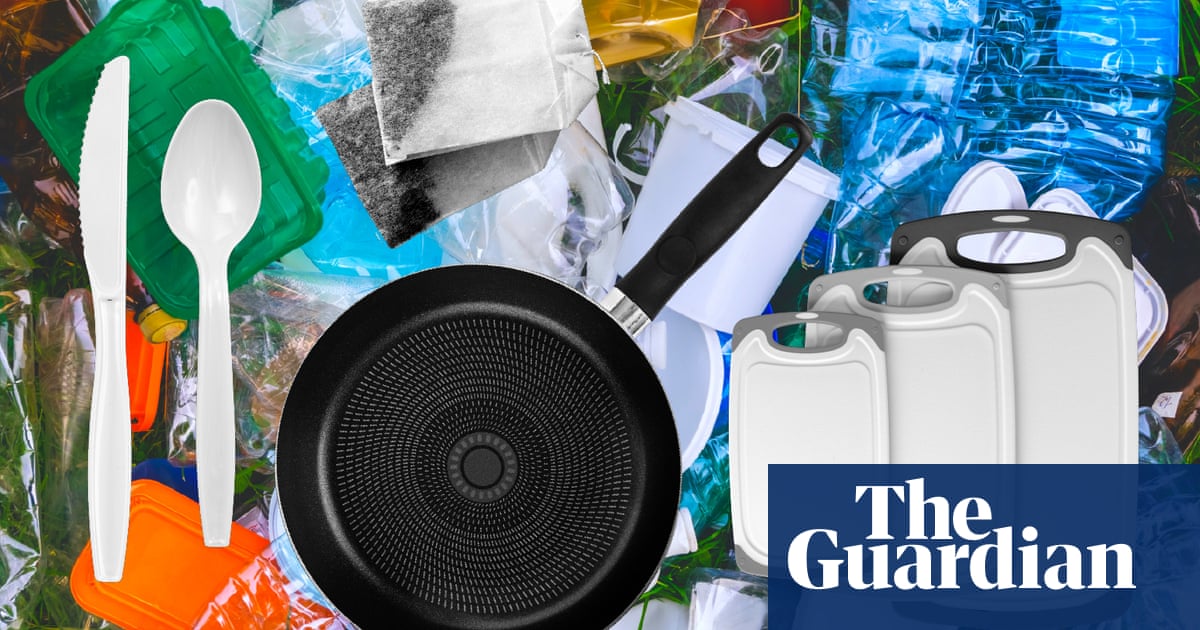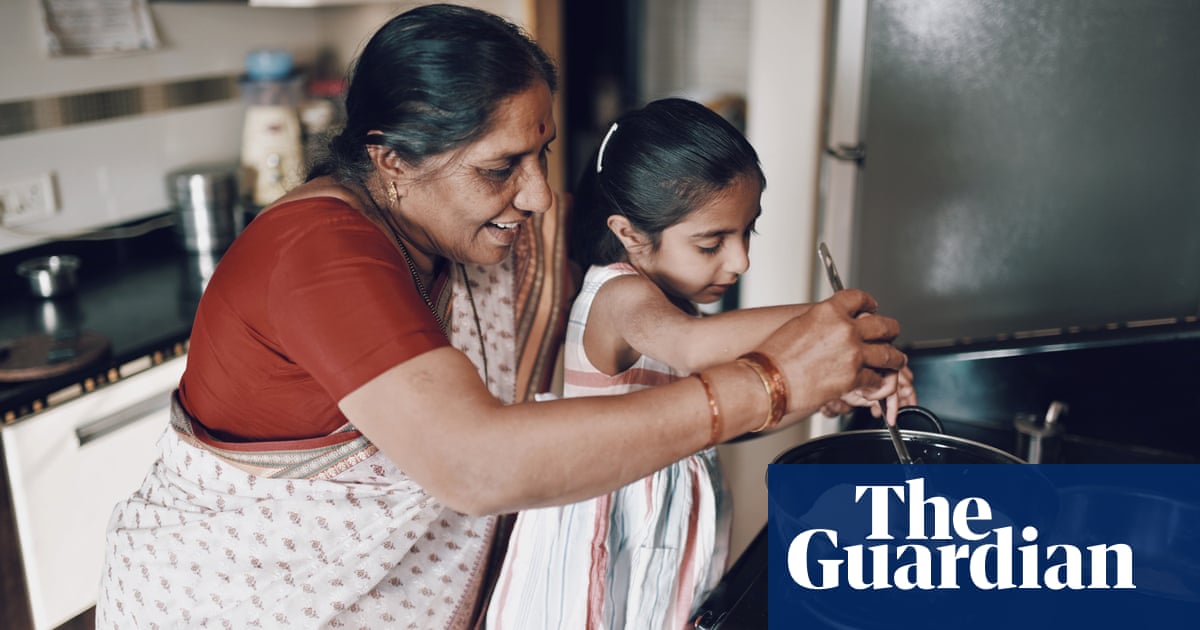
Cutting boards, non-stick pans, mixing bowls, even tea bags: in the kitchen, plastics can be hidden in plain sight.
It’s something that Jessica Brinkworth, an anthropology professor at the University of Illinois at Urbana-Champaign, realized once she began looking for ways to cut down on plastic use in her own kitchen after her workplace started doing the same. Although much of her lab’s waste was unavoidable – plastics are key for the sterile medical research they conduct – it still made her uncomfortable. That discomfort was only magnified in her own home, where she knew plastics were “largely a matter of convenience”.
“Large macroplastics are a problem worldwide because we dump them on the shores of other nations,” she says, where things like plastic bottles block access to food for coastal nations and kill about a million people a year due to flooding, landslides and other environmental disasters. Much smaller plastics, like micro and nanoplastics, which are tinier than a grain of rice, “pose a whole other level of problem. Many types of plastic are endocrine disruptors,” meaning they disrupt the excretion and use of insulin, which can lead to obesity and reproductive health disorders.
Every year, we dump 10m tons of plastic into the ocean, killing a million marine animals annually. That plastic can work its way into our bodies from both the food we eat (most of our seafood contains microplastics) to how we cook in the kitchen.
“Plastic pollution is one of the most visible signs of the environmental crisis we’re facing with microplastics discovered on the highest mountains as well as in the depths of the oceans,” said Paula Chin, a senior policy adviser on consumption at the World Wildlife Fund. “They’ve also been found in our bodies with estimates suggesting we’re consuming a credit card’s worth of plastic each week.”
Brinkworth says solving our plastics problem will require massive regulatory action and coordination by federal and world governments, but that there are important ways consumers can make a difference.
“There’s so much that we’re producing in our kitchens that’s environmentally and publicly hazardous. But the reason why it’s in our kitchens is because that’s been made available to us,” she says. “One of the great acts of the plastics and petroleum industry has been to convince us that it’s a personal responsibility.”
That said, Brinworth notes that the climate crisis is happening now – and many people won’t survive waiting for innovative plastics recycling solutions to save the day. She encourages people interested in combating plastic pollution to reduce, reuse and recycle – but most importantly to refuse, when they are able. “Consumers can take responsibility probably in the most effective way by trying to affect government change.”
Here are Brinkworth’s and other experts’ tips on ways to reduce and refuse plastic waste in your kitchen.
Shopping
Plastics are omnipresent at the grocery store – think of the cellophane used to cover pre-chopped mushrooms, milk cartons, and packages of pre-sliced meats. It’s difficult to entirely avoid them, but, Chin says, “there are ways to cut-back.”
The first and most important way to do that, she says, is to simply buy less. “Make a conscious choice to avoid buying products you don’t need and when you do, look for products that are made from sustainably sourced natural materials.” The more you cook from scratch, the less plastic you’ll use from packaged or processed foods (think about all of the plastic used to wrap frozen vegetables, cover chopped produce and package frozen dinners).
When shopping, not just for groceries but also for kitchen appliances, Chin recommends first questioning whether you need something, then trying to reuse what you already have, before finally looking “for options which include recycled content.” That won’t save you the health risks of plastic use, but it can have a significant environmental impact. According to a 2021 report from the World Economic Forum, reusing just 10% of plastic products, could prevent almost half of annual plastic ocean waste.
If you haven’t already gotten in the habit of taking your own bags to the grocery store, start – and while you’re at it, consider adding your own reusable produce bags. But shopping at traditional grocery stores isn’t your only option: more zero-waste shops are springing up across the country (where you can bring your own containers or use non-plastic ones the store offers to take home exactly as many lentils or bunches of broccoli as you’ll use) and plenty of farmer’s markets allow customers to bring their own glass jars or produce bags so you’re not toting home plastic cartons. Depending on where you live, you might even be able to swap plastic milk cartons for glass bottles (and rekindle the nostalgia of a visit from the milkman) by opting into a milk delivery service.
Cooking
You might not think there’s very much plastic in your kitchen if you’re only thinking about clear packaging, but almost every household is home to at least some plastic kitchen appliances. Think about your cutting board, mixing bowls, non-stick (Teflon-coated) pans, spatulas, blender or food processor.
Plastic appliances can release high levels of micro and nanoplastics, says Brinkworth, especially if we’re heating with, chopping on or blending in them.
Earlier this year, researchers at North Dakota State University published a study that found that chopping on plastic cutting boards can release millions of microplastics each year. Other recent research has counted the microplastics released from using plastic mixing bowls, blenders, kettles and non-stick pans.
The best way to avoid that? Switch your plastic appliances out for metal, glass or wooden ones where possible, says Brinkworth. But be careful when looking at wood or bamboo appliances that you consider the glue used to hold them together. Even just the glue used to seal a tea bag can release billions of microplastics.
Storing
Plastic wrap has easily one of the greatest impacts on the environment: we only ever use it once and it can take close to 1,000 years to decompose in landfills. And plastic packaging – think cling wrap, sandwich bags and candy wrappers – makes up almost half of the plastic waste that ends up in the ocean. It’s so convenient that it can be difficult to imagine any good alternatives, but Brinkworth encourages consumers to try reusable alternatives.
The price point for reusable cling wrap can be high, which is why Brinkworth and her family made their own. It’s pretty simple: cut cotton fabric to the sizes you’d like your cling wrap to be, lay them out on a baking sheet in the oven and cover them with beeswax (Brinkworth recommends adding jojoba oil to make the wraps more flexible), and bake for two to three minutes. If all that sounds like too much work though, you can pick up reusable beeswax cling wrap at many grocery stores.
Brinkworth says the reusable cling wrap is easy to clean, but will eventually start to flake. “Honestly, a simpler solution for most people would be just to use mason jars,” which you can find for about a dollar a piece at many thrift stores. In general, switching to glass jars (or glass storage containers, if they’re in your budget) is better for the environment and your body. Plastic containers can leech cancer-causing and hormone-disrupting chemicals into your food.
Cleaning
If you thought you had cleared your kitchen of plastics, the prevalence of plastic in your cleaning routine might surprise you. Dishwasher pods get the worst rap (the polyvinyl alcohol wrapping doesn’t break down in water treatment plants), but if the interior of your dishwasher is made out of plastic, it’s releasing microplastics with every wash. Few dishwashers have no plastic whatsoever, says Brinkworth, but she recommends splurging for a stainless steel interior if you can afford it (or hand washing when your life allows).
Handwashing won’t get rid of all the plastics in your kitchen though either – if you’re using liquid dish soap, it’s likely packaged in a plastic bottle. Fortunately, a few brands have started selling dish soap bars and liquid dish soap packaged in cardboard. Most sponges are made of plastic too, but more stores are selling natural sponges and dishcloths as demand increases. Those can be worthwhile alternatives to keep plastic out of your own body and from slipping down the drain.












